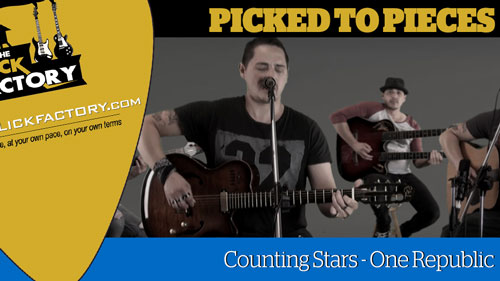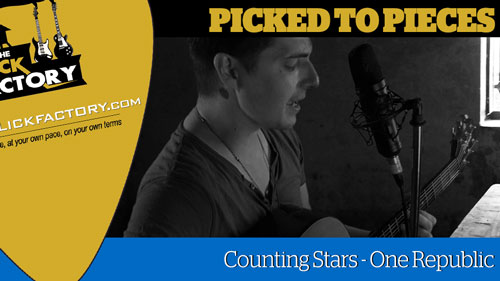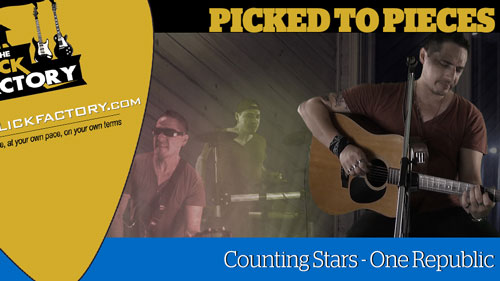Picked to Pieces #7 – Stupid Boy
Picked to Pieces – Stupid Boy Transcript:
Why this song?
There were a couple of reasons. First one being that I missed out on playing at the Country Music festival at Tamworth this year. I didn’t go up to it so I haven’t gotten the country out of my system for the past 12 months.
So I thought, yeah I’d give it a go…but the main reason was that I love Keith Urban as a player. He’s a fantastic guitar player and a great song writer. I really love what he does so I thought what better way of paying homage to that then giving a cover a go.
How did you approach the parts?
I kept the intro lick exactly the same, I wanted to pay homage to the original that way. It’s an awesome lick, I really enjoy paying that. I actually did it exactly the same way as Keith did. So I had the capo on the 2nd fret and if I ignore the key change for a sec, what I’m basically doing is using a version of a G shape because he also has a Drop D tuning so we have D A D G B E. So I’m starting with basically a G. A standard G shape would be like that, It’s just with the drop tuning, the tonic becomes here. And then he’s playing basically a G suspended 2nd, adding the A, the 2 or the 9 and bringing that up to the tonic. To the B. So that part of the licks the same, then going to the D to the A.
All the other parts, I played without the capo. I actually used standard positioning so I was playing an A to an E shape, to a B. And basically what I did was have 4 parts running at the same time. So I had that intro lick which is linked to a second part, which is the second rhythm part. It starts where the verse comes in, where basically what I was playing was…
And what I’m basically doing is starting off with that A, then bringing it down to an A Major 7. I’ve got the A there, then dropping it down a semitone to the G# which is the Major 7. Then I’m hitting an E power chord. Because I’m in Drop D tuning I’m getting the E and the B, the 1 and the 5th then the repeat of the E and B. So it’s an E5 or the E power chord. But what I do towards the end of that is bring in the F# so it becomes an Esus2. Then I finish the whole thing off with a B5. And the whole picking pattern is a real pick slap approach. And that remains consistent throughout the entire song, even when I hit the choruses & solos at the end. I’ve always got that part in there because what its doing is adding that percussive element while also filling out the body a bit for me to be able to solo and play around with the main part.
Speaking of the main part…
That main part, the main rhythm guitar part is played with Drop D tuning as well. That was actually the first part that I put down. So I used that as a reference point for building up the rest of the track.
Probably the most notable thing I did on it was that riff. The A to the A Major 7 to the B, but what I did was I pushed every chord. The original is very straight. It’s very on the beat. And what I did was push everything by an eighth. Everything starts hitting on the off beat. And I kept that going in the choruses as well.
So every time it’s pushed except for that A. So every time I go back to the start of the progression, that’s on the 1.
The rest of that rhythm part, what I basically did was play around with fillers in-between each progression. I also played this with a pick because I had the other part filling it out that way. So this one I strummed. First time in the intro, I just left it sustain. The second one…
When I hit the pre-chorus. The first time through, I used an octave run, which is basically just using the notes of an E major scale. Which again is something that I like to do. I’m going from the B which is the 5th, up to the 6th, up to the Maj7th, then to the E. So it’s just basically running up the scale as Octaves.
What about the chorus?
It was the same basic idea except that I had this one filler lick in there.
Which is something that I like to do. Its like my standard filler riff that I like to use over a B. I’m taking the 5th and hammering it on u to the 6, then down to the 5th with the harmony on the octave the whole time. I then slide down from the Major 3rd to the 2nd and then back to the tonic, then back up to the 3rd and up to the 5th and the tonic again.
Its basically one of those types of licks. I’m playing around with that B shape at the end of the day. I’m chucking in the suspended at the end.
So that was the only real tricky thing I did in the chorus. Apart from that its pretty straight.
Lets talk about the solo…
It’s straight E majors, but I thought of it a lot from the pentatonic perspective. Probably the only real noticeable things in that first acoustic solo that sticks out for me is that….
I started it off with one of those types of runs. This is a pentatonic lick I got from an old master class video from Paul Gilbert years ago. But it’s basically using a pentatonic scale starting on the tonic. So I’m using a C# minor here… And I’m using a triplet here.
I’m basically repeating the pattern on the next string. So I do that twice and I”m double timing that as well so it becomes a six.
There’s the 1 again. And then finish off with the … 2 beats on a triplet or a sextuplet run down on the top of the pentatonic scale. Starting from that B , so I’m in position 1 of the minor pentatonic there. SO I have my forth finger coming down on the 1st then onto the 3rd finger on the G string , then just sliding out.
It’s actually a very standard type of blues type of progression.
When I got to the last acoustic solo, I started off with the theme of the song that you hear in the original recording a lot. So I started off with that one line. And then took it from there. Again I took a very standard type of approach to it. I through a couple of fast licks in there as I was starting to build it up. Something like that, which is basically just running down an E major scale. So I was thinking in position 1 as a Root 5 or a B mixolydian mode and then sliding down into the next position, then finishing off in the pentatonic. With a very pentatonic type of lick
Why did you shift to the Electric Guitar?
I found that as I was building the solo, I go to a point where I was building it and building it. And it got to that point half way through where I thought I either had to finish the song here or I need something else to kick it in the butt. SO it started off with me pulling out the electric and just jamming on it. And then I started playing the solo. That solo that’s actually there now, I recorded that with none of the backing . I actually hadn’t done it yet. I played it with the percussion and the original acoustic track. I played that and I though ‘you know what, that’s what it needs’. So I actually built it in reverse. I started with the solo, then I added the rhythm guitar parts, then the drums and then the bass. It just got to that point where I wanted to keep it acoustic but to me it was just screaming for that. I hadn’t done that yet, I used a little bit of electric in say something, but I though im ust gonna rip out the electric and go for it, and that’s what I did.
_____________________________________
Learn to play the guitar!
In your own time, at your own pace, on your own terms…




